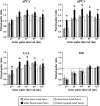Neonatal odor-shock conditioning alters the neural network involved in odor fear learning at adulthood
- PMID: 18772252
- PMCID: PMC2632787
- DOI: 10.1101/lm.998508
Neonatal odor-shock conditioning alters the neural network involved in odor fear learning at adulthood
Abstract
Adult learning and memory functions are strongly dependent on neonatal experiences. We recently showed that neonatal odor-shock learning attenuates later life odor fear conditioning and amygdala activity. In the present work we investigated whether changes observed in adults can also be observed in other structures normally involved, namely olfactory cortical areas. For this, pups were trained daily from postnatal (PN) 8 to 12 in an odor-shock paradigm, and retrained at adulthood in the same task. (14)C 2-DG autoradiographic brain mapping was used to measure training-related activation in amygdala cortical nucleus (CoA), anterior (aPCx), and posterior (pPCx) piriform cortex. In addition, field potentials induced in the three sites in response to paired-pulse stimulation of the olfactory bulb were recorded in order to assess short-term inhibition and facilitation in these structures. Attenuated adult fear learning was accompanied by a deficit in 2-DG activation in CoA and pPCx. Moreover, electrophysiological recordings revealed that, in these sites, the level of inhibition was lower than in control animals. These data indicate that early life odor-shock learning produces changes throughout structures of the adult learning circuit that are independent, at least in part, from those involved in infant learning. Moreover, these enduring effects were influenced by the contingency of the infant experience since paired odor-shock produced greater disruption of adult learning and its supporting neural pathway than unpaired presentations. These results suggest that some enduring effects of early life experience are potentiated by contingency and extend beyond brain areas involved in infant learning.
Figures




References
-
- Anisman H., Zaharia M.D., Meaney M.J., Merali Z. Do early-life events permanently alter behavioral and hormonal responses to stressors? Int. J. Dev. Neurosci. 1998;16:149–164. - PubMed
-
- Barr G.A. Ontogeny of nociception and antinociception. NIDA Res. Monogr. 1995;158:172–201. - PubMed
-
- Bell R.W., Denenberg V.H. The interrelationships of shock and critical periods in infancy as they affect adult learning and activity. Anim. Behav. 1962;11:21–27.
-
- Blanchard R.J., Blanchard D.C. Crouching as an index of fear. J. Comp. Physiol. Psychol. 1969;67:370–375. - PubMed
Publication types
MeSH terms
Grants and funding
LinkOut - more resources
Full Text Sources
